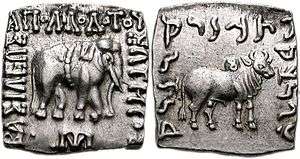Nandipada


The Nandipada ("foot of Nandi") is an ancient Indian symbol, also called a taurine symbol, representing a bull's hoof or the mark left by the foot of a bull in the ground. The nandipada and the zebu bull are generally associated with Nandi, Shiva 's humped bull in Hinduism.[1] The Nandipada symbol also happens to be similar to the Brahmi letter "ma".
The Nandipada appears on numerous ancient Indian coins, such as coins from Taxila dating to the 2nd century BCE. The symbol also appears on the zebu bull on the reverse if often shown with a Nandipada taurine mark on its hump on the less worn coins, which reinforces the role of the animal as a symbol, religious or geographic, rather than just the depiction of an animal for decorative purposes. The same association was made later on coins of Zeionises or Vima Kadphises.[1][2]
The Nanpida symbol saw later evolution, especially with branches becoming more decorated. It is sometimes associated or confused with the Buddhist Triratna symbol. The term is also often used in numismatics.[3]
References
- 1 2 Many Heads, Arms, and Eyes: Origin, Meaning, and Form of Multiplicity in Indian Art, Doris Srinivasan, BRILL, 1997, p.224
- ↑ Monnaies Greco-Bactriennes et Indo-Grecques, Bopearachchi, p.189
- ↑ CNG Coins notice